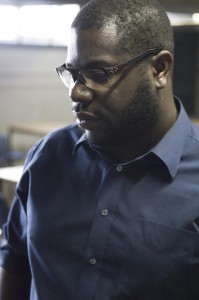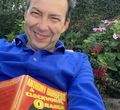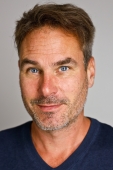Pushing the Audience Away

Steve McQueen
Winner of the EUROPEAN DISCOVERY 2008 for HUNGER
directed by Steve McQueen
written by Enda Walsh & Steve McQueen
Steve McQueen received the award European Discovery 2008 for his first long feature film HUNGER. The film has been extremely well-received by critics, audiences and at festivals all over the world, winning the Caméra d’Or in Cannes - among many other prestigious prizes.
The film is about the last six weeks in the life of Irish Republican Army hunger striker Bobby Sands. The hunger strike was a political tactic in the long-running battle over prison conditions .Bobby Sands was the first of ten men to die in 1981.
Steve McQueen was born in London in 1969. Between 1989 and 1994 he studied at Chelsea School of Art, Goldsmiths College, and the Tisch School of the Arts. In 1999 he received the Turner Prize for his film installation exhibition at the Institute of Contemporary Arts.
Here he talks about his personal reasons to make this movie, how it was being a first time feature film director and his urge to push the audience away in order to make them see and listen - in what has been called one of the greatest scenes in film history ever.
Why do you think that the European Film Awards are important?
Well, first of all because I see it as a contrast to the Oscars. I think somehow it is important to distinguish between Hollywood, Nollywood [the African, particularly Nigerian film industry], Bollywood [the Indian film Industry], and Europe. The two strongest film traditions are the American and the European.
And I think we Europeans have a different sensitivity and sensibility to the films we make - which is great and important to celebrate.
The European sensitivity and sensibility - describe what you mean by this notion?
No film can be divorced from sensibility and sensitivity but it can be different. All I can say is that if you look at the European vision - although maybe not completely - there is always somehow a critical look - at the work in general from critics and filmmakers themselves. There is not always a happy ending. Not to say there is always a happy ending in American movies but we somehow have a different perspective…
This is your first long feature film - why about Bobby Sands?
When I was 11 years old I had this turning point episode. One evening I saw an image of a man [Bobby Sands] on television with a number. The number indicated the amount of days the man had been on hunger strike.
I didn’t know what a hunger strike was and went to ask my mother who explained what it entailed. This man was at a hunger strike to be heard. For an 11-year-old kid this was very strange, that in order to be heard by someone he had stopped eating - and I reflected a lot on how not eating makes a voice become louder.
Somehow this episode indicates the beginning and the end of my childhood. It was like I started to see the cracks in the walls of my surroundings. The episode destructed me.
Many years after this I decided to make this film. Why? Maybe to try to see it myself - to consider myself what that person was trying to do.
So how did you get the project started?
The journey started five years ago. And as many things in life it’s all a question of opportunity, access and money, and it was one of these things that happened. I interviewed five writers and then suddenly with one [Enda Walsh] it just clicked - he was not afraid in any way.
We started to do a lot of research - we went to Belfast to the Maze Prison. We did research throughout a very heavy week of interviewing people. We talked to former prisoners who had been involved with the hunger strike and one former prison officer.
The experience of this week was so heavy that we didn’t speak to each other for a week afterwards. You see, it was like carrying a weight - and each person you talk to gave you one more brick to carry.
For you as a debutant where did you get your support?
Support - I don’t know, you have to support yourself. You see, there is no time to put the hands on your head admiring yourself, “Oh! Ha! I am a director now!” As soon as it starts it’s like you get thrown into the deep end in the swimming pool and you got to learn to swim NOW - not tomorrow, not the day after tomorrow but now.
But your vision for the film - not having worked with actors before - what was your idea for communicating that vision?
I think that I have a gift for that - it is a huge part of me to communicate throughout my art. The big new thing was of course working with the actors. I love actors and the acting, and somehow I new that you have to build up trust.
I often think that directors don’t tell the whole truth. I think it is important to tell the whole truth - because once actors know what you’re talking about they are even willing to go further, to try to be even better. And the way I like to direct is to have that true conversation and push it, push it further. So instead of acting or performing the role - it’s actually being the role. You can achieve that but it’s a lot of energy, a lot of time to get there.
And your vision for this almost uncoloured image in the film?
Well, we were not allowed to shoot in the Maze Prison. They didn’t give us the access so we had to build the set. I thought about the natural light and the artificial light you often see in public institutions, in old hospitals and schools. That kind of environment is very artificial and at the same time sterile. When you put characters within that setting you really focus on them, you are drawn to the people - nothing disturbs you.
Tell me about your thoughts for the scene between Bobby Sands and the priest. 17 ½ minute for one take - the scene is 22 ½ minutes long altogether and has been mentioned to be one of the greatest film scenes in film history.
It is very straight forward. And in fact it is very simple. If we were to film this scene where you and I are talking to each other there would be a camera on your shoulder shooting me and one on my shoulder shooting you. So we wouldn’t have a conversation with each other, we would have a conversation with the audience. The whole idea of making this scene in one shot was to have action and reaction in the same situation.
The scene is a conversation about the reasons to live and the reasons to die - to have this kind of confrontation I needed for me to have direct contact. I wanted to make a room where I allowed the conversation to develop.
In the beginning of the scene it seems to be a conversation about nothing really but actually it’s about a lot. Two men are checking each other out - and then we get on to the most important conversation. Bobby Sands talks about the importance of the proposed hunger strike - and the priest talks about why it is more important to live rather than die. It’s about two stones making fire.
The reason for me to do the scene this way was to make it intimate. I wanted to push the audience away. Because what happens is that the eyes of the audience become much sharper and the ears become much more tuned in. You see the silhouettes, you can hardly see the expressions - but you are leaning in so you can better listen. That is why you stick to the scene. People can hardly believe it is 22 ½ minutes - they think it is 5-7 minutes long. You have the feeling of real time and not film time.
Was your aim with the movie a political one?
For me this is not a film about left or right. I want the film to cause debate. For me it’s a film about you and me. I want people to get involved, respond and react.
Interviewed by Frederikke Lett in Copenhagen, December 2008.









